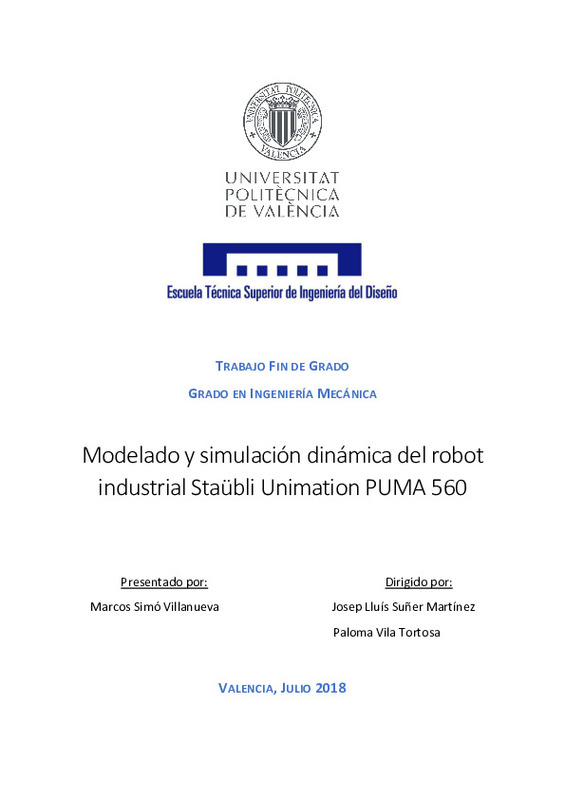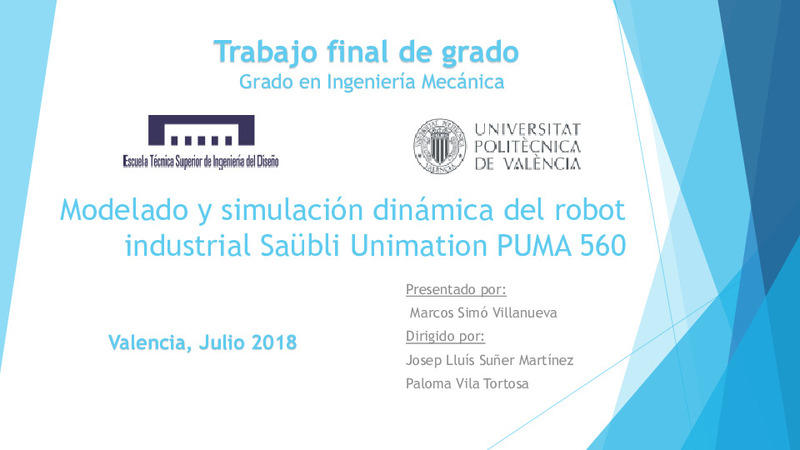|
Resumen:
|
[ES] Este Trabajo Fin de Grado se enmarca dentro de la línea emprendida hace tres cursos para la realización de una serie de trabajos sobre modelos dinámicos de robots industriales, trabajando conjuntamente con el entorno ...[+]
[ES] Este Trabajo Fin de Grado se enmarca dentro de la línea emprendida hace tres cursos para la realización de una serie de trabajos sobre modelos dinámicos de robots industriales, trabajando conjuntamente con el entorno de simulación dinámica ADAMS/View y un programa de cálculo numérico como Matlab. El robot Staübli Unimation PUMA 560 es un robot de articulado con seis grados de libertad y se considera uno de los robots más importantes de la historia de la robótica, tanto por el número de unidades que se fabricaron e instalaron como por la abundante bibliografía científica que generó. El hecho de poder acceder a esa bibliografía y poder hacer comparaciones de los resultados obtenidos en el TFG con los encontrados en búsquedas previas, justifica el realizar el trabajo sobre este robot. Por otro lado, el Departamento de Ingeniería Mecánica y de Materiales dispone de un ejemplar de este robot, lo cual permite acceder a mediciones y comprobaciones de manera más fácil que en otros modelos El proyecto comenzará con la recopilación de la información necesaria para la realización del modelo, mediante consulta en bibliografía técnica y trabajo en el DIMM sobre el robot disponible. El siguiente paso será la construcción del modelo con los programas ADAMS/View y Matlab. En ADAMS/View se construirá el modelo tridimensional y en él se programarán los movimientos del robot que permitirán resolver los problemas cinemáticos y dinámicos, tanto directo e inverso en ambos casos. En Matlab se construirá el modelo analítico a partir de la información recopilada en la fase anterior y que dará como resultado un conjunto de ecuaciones que permitirán resolver los mismos problemas que con el modelo obtenido con el programa ADAMS/View. La última fase será la comparación de ambos modelos, debiendo obtenerse los mismos resultados en ambos casos, lo que dará validez a los modelos realizados.
[-]
[EN] This Final Degree Project is part of the line undertaken three years ago to carry out a series of works on dynamic models of industrial robots, working in conjunction with the ADAMS / View dynamic simulation environment ...[+]
[EN] This Final Degree Project is part of the line undertaken three years ago to carry out a series of works on dynamic models of industrial robots, working in conjunction with the ADAMS / View dynamic simulation environment and a numerical calculation program such as Matlab. The Staübli Unimation PUMA 560 robot is an articulated robot with six degrees of freedom and it is considered one of the most important robots in the history of robotics, both for the number of units that were manufactured and installed and for the abundant scientific literature that it generated. The fact of being able to access this bibliography and be able to make comparisons of the results obtained in the FDP with those found in previous searches, justifies doing the work on this robot. On the other hand, the Department of Mechanical and Materials Engineering has a copy of this robot, which allows access to measurements and checks more easily than in other models. The project will begin with the compilation of the necessary information for the realization of the model, through consultation in technical bibliography and work in the DIMM about the available robot. The next step will be to build the model with the ADAMS/View and Matlab programs. In ADAMS / View the three-dimensional model will be built and the movements of the robot that will allow to solve the kinematic and dynamic problems, both direct and inverse in both cases, will be programmed. In Matlab, the analytical model will be constructed based on the information gathered in the previous phase and will result in a set of equations that will allow to solve the same problems as with the model obtained with the ADAMS/View program. The last phase will be the comparison of both models, obtaining the same results in both cases, which will validate the models made.
[-]
|






![ZIP archive [ZIP]](/themes/UPV/images/zip.png)


